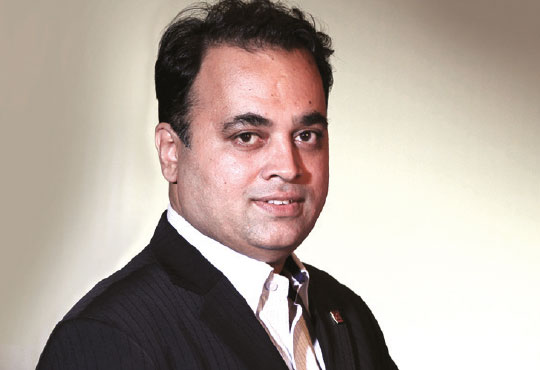
Corporate Bond Markets Finally Taking Off
Jayen Shah, Executive Vice President & Head - Debt Capital Markets, IDFC BANK | Wednesday, 11 October 2017, 04:44 IST
 For eternity, financial market participants have debated over the deepening of the Indian Corporate Bond Markets. The subject matter has not only been very close to my heart but at the core of my professional experience for the past 21 years. Finally, I am of the opinion that Indian bond markets are taking off!
For eternity, financial market participants have debated over the deepening of the Indian Corporate Bond Markets. The subject matter has not only been very close to my heart but at the core of my professional experience for the past 21 years. Finally, I am of the opinion that Indian bond markets are taking off!
YTD 2016 has witnessed record volumes, over INR 400,000 crore, of bond issuances and adding public bond issues and state government securities under the UDAY scheme, the gross volume crosses INR 450,000 crore. This is a staggering number by any yardstick. Single issuance of over INR 5,000 crore and tenors of 15 years and longer have been successfully subscribed by investors. Wide-ranging issuers have accessed bond markets, though bulk of issuances would have been by AA or higher-rated issuers.
Do note that the below discussion refers to the private placements (over 95 per cent of all issuances), both by number of issues, volume and bonds that are generically referred for non-convertible debentures.
Indian bond markets are unique in many ways. Unlike bond markets of developed economies where underwriting is an extreme rarity, in India, a large proportion of bond deals are either underwritten or bought-out by underwriter-arranger. Despite this ‘evolution’ of Indian bond market, it still needs to leapfrog in many other aspects. Reforms are warranted for- a thriving secondary market; widening access to issuers with ratings below the ‘AA’ rating handle and non-investment grade issuers; in the regulations governing investors; rationalization of issuance stamp duty; credit risk hedging markets; enforcing common market standards – to list some areas.
Bond markets provide an alternate source of financing to borrowers, some of the key advantages being-
• Lower than loan funding rates with predominance of fixed rate securities while loans on floating rate basis.
•Coupon payment frequency can be structured
– ranging from annual-pay to coupon payment at maturity. Also, the coupon value can be structured as lower-coupon in initial years. Bank loans need to pay interest on monthly basis.
• Execution timelines for bond issues are generally shorter than loan financing
• Diverse investor base – mutual funds, insurance companies, pension and retiral funds, corporate treasuries, foreign portfolio investors (FPIs), High-net worth individuals, etc.
• Proceeds can be deployed to meet varied requirements- from traditional working capital finance, ongoing capex, refinancing to project finance, acquisition finance and land purchase finance. Essentially, it is possible to use funds to meet different needs, beyond what is permissible by banks. End-uses for funds may include, but not limited to: Acquisition financing, i.e. for purchase of shares of the target company (Nirchem Cement’s maiden bond issue to finance acquisition of Lafarge India)
• Real estate financing, including land purchase, construction, commercial mortgage-backed securities (CMBS) for office and retail mall space;
• Structured bonds and securitized instruments –
• Inflation-indexed bond;
• Floating rate, variable rate, resettable bonds;
• Coupon linked to performance of observed indices, like equity linked instruments (ELNs);
• IIFCL & ADB partial credit enhanced bond (e.g. ReNew Wind Energy (Jath))
• Refinance of completed and operational infrastructure projects – e.g. project bonds in transmission sector, toll-roads, NHAI-annuity roads; securitization of future receivables (e.g. storage facilities of IoT Utkal in energy sector); green bond(e.g. by CLP Wind Farm)
• Mezzanine debt and subordinate debt supplementing equity capital, e.g. sub-debt by project companies, sub-debt by NBFCs, banks, etc.
• Holdco financing, i.e. sponsors and promoters have issued bonds from their holding companies to augment their shareholding or onward lending to JV or step-down subsidiary.
Essential items that need to be completed by a corporate desirous of issuance, include -
a) Shareholders/members enabling resolution for issuance of securities;
b) Appointment of arranger or underwriter (an experienced bond-house will ensure compliance for first time issuers)
c) Appointment of rating agency, debenture trustee, registrar and transfer agent,
d) Appointment of external legal counsel for the transaction (depending on the deal complexity)
e) Consent for listing from listing agency
f) E-bidding (this is recent addition by SEBI for transparent price discovery)
g) Agreement with security depository (CDSL or NSDL)
h) Allotment of the bonds
i) Post-allotment processes include bond listing, providing demat credit to bond-holders, execution of trust deed and creation of charge on the security.
Key documents that are likely to be executed, include – information memorandum (and PAS4, adhering to provisions of Companies Act, 2013), debenture trust deed (DTD), debenture trust agreement (DTA), rating letter, listing (if listed), mortgage deed or deed of hypothecation (if secured).
Issuers have a choice of either onshore or offshore bonds. Offshore bonds – in USD or EUR, etc. issued under Reg S/144A format, listed at an offshore exchange, to international investors. RBI, in Sept 2015, permitted Indian borrowers to issue INR denominated bonds (‘Masala bonds’), of minimum 3-year tenor (lowered from 5-year), issued offshore to international investors. HDFC Ltd was the first to issue Masala Bonds.
There is visible vigour amongst regulators and government departments to implement various recommendations for deepening of the corporate bond markets. This coupled with market forces gives me confidence that corporate bond markets are taking off, finally!!
CIO Viewpoint
Machine Learning In Cybersecurity: The Risks &...
By Neelesh Kripalani, Chief Technology Officer, Clover Infotech
5 Major Saas Trends To Check-Out In 2021
By Vikas Bhonsle, CEO, Crayon Software Experts India
Artificial Intelligence & The Disruptive Chatbot
By Vishal Sinha, President & CIO, Tranzlease Holdings
CXO Insights
Crafting the Digital Journey in Banking
By Janifha Evangeline
Incorporating Blockchain Capabilities into...




.jpg)
.jpg)





